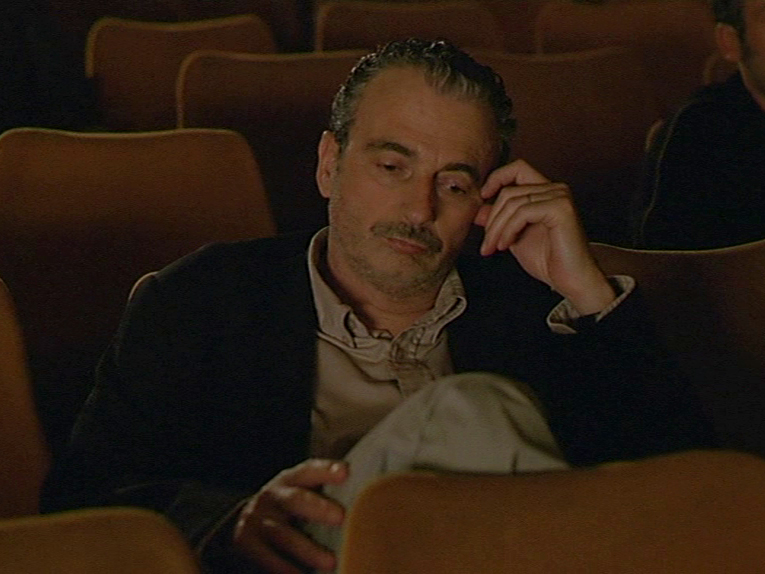
In a heterosexual film theatre... A love story between the cashier, a fifty-year-old and the - much younger - projectionist... The cashier will seduce the fifty-year old man through the simplicity of the young projectionist... The fifty-year old man will use his complicity with the cashier, in order to seduce the young projectionist... The cashier will tell us her story... We will learn that she has left home at the age of sixteen... came to prostitution... Her life was very much the same than the fifty-year-old man... The fifty-year old man is an occasional writer... former gigolo... He will tell us his story with a humorous touch...
« Fermé depuis quelques années, le [cinéma] Méry a rouvert ses portes à Jacques Nolot, comédien, cinéaste, qui y a organisé une cérémonie à la fois orgiaque et nostalgique, placée sous le totem de La chatte à deux têtes, film à caractère pornographique inventé pour servir de prétexte au film à caractère autobiographique de Nolot.
Ce caractère autobiographique se signale d'abord par la présence du réalisateur dans le rôle d'un poète malade qui hante régulièrement cette salle, mais aussi par l'évocation assez précise d'un paradoxe souvent ignoré : les salles projetant des films classés X montrant des coïts hétérosexuels servaient de lieu de rencontre aux homosexuels. Le commerce amoureux que montre Nolot dans cet environnement d'une forte couleur sordide (avant de s'asseoir, les habitués examinent leur fauteuil à la lueur d'un briquet) n'a rien de ragoûtant. Les premières fois qu'il montre ces corps plus qu'imparfaits, que le travestissement tire encore vers le ridicule, la répulsion guette. Mais Nolot est un metteur en scène patient, qui, en même temps qu'il épate le bourgeois, compose une toile d'araignée de désirs et de relations amoureuses qui fait la vraie substance de La chatte à deux têtes. »
Le Monde1
“Jacques Nolot, with his gentle gaze, graying hair and thin 1920’s mustache, has been a familiar figure in French films for several years; he appears in many of André Téchiné's movies (he's the shoe salesman to whom the gay teenager turns for advice in Wild Reeds) and helped write Mr. Téchiné's J'embrasse Pas (1991), about a boy from the provinces who becomes a hustler in Paris. With Porn Theater, [...] Mr. Nolot continues his concern with gay characters looking for their place in the world. Set in a seedy adult movie theater in an unnamed section of Paris (the camera never ventures beyond the theater’s foyer), the film examines the temporary community that comes into existence every night as the regular patrons shuffle in, one by one, for another evening of hopeful cruising and brief encounters. [...] For Mr. Nolot, the social interaction in the audience is far more important than the sexual interaction on the screen. [...] Some of the men solicit attention; others seem determined to avoid it. But all are there in search of a human connection, however short or sordid. Porn Theater functions best in its voyeuristic, sociological mode, offering fragmentary glimpses of complicated lives and the complicated social rituals that shape them. The characters are constantly changing seats, acting out an elaborate choreography of desire and denial.”
Dave Kehr2
« Comprehension et compassion des deviations de la nature humaine, écoute de l’appel, chorégraphie sexuelle, “tout le monde est le refoulé de lui-meme”. Avec franchise et dignité, avec compassion, Nolot observe l’hypocrisie, la solitude, la frustration, le manque. Comment on fait pour s’en sortir ? »
Jean Decock3
“I like to please, I like to seduce, but at the end of the day I'm making a film. [...] From the moment it becomes a film, I begin to acknowledge my flaws. I no longer belong to myself, I belong to the story. When I write, I think of myself as a painter. I put myself in a creative state – a state of neurosis and anguish. Before, this was unconscious, but it has become less and less so with age. I feel like I'm splashing bits of dialogue the way a painter splashed color on a canvas, and I have to let myself go. And I always take care not to become too intelligent: when I think about something, I rework it and it turns out worse.”
Jacques Nolot
“Let’s be clear that a fantasy requires a setting (a scenario) and therefore a place.”
Roland Barthes4
“When the film was released, a few critics predictably pursed their lips. In Nolot’s world, homosexuality has none of the sequined hysteria of La cage aux folles or Pédale douce, two French box-office hits. As in Gore Vidal, the film’s dance of sex ebbs and flows according to the rhythm of desire (or financial need), disrupting the genre’s conventions and complicating the issues of identity politics and sexual orientation (homo or hetero, male or female, drag queen or transsexual). A regular rails at the transvestites for spoiling things; a bald, paunchy man puts on a wig – his last hope for picking up a little sex. With a lateral tracking shot Nolot shows men in the theater, their backs to the camera, zombified by sexual tension – the pathos of flesh that can only consummate its desires under the pressure of the final countdown.”
Elisabeth Lequeret5
- 1« “La Chatte à deux têtes” : sur et sous l'écran, le chassé-croisé des désirs interdits, » Le Monde, 19 novembre 2002.
- 2Dave Kehr, “FILM IN REVIEW; ‘Porn Theater’,” The New York Times, 10 October 2003.
- 3Jean Decock, « 55e Festival International du films de Cannes 2002, ou la Dispersion (première partie), » The French Review, Vol. 76, No. 4 (Mar., 2003).
- 4Roland Barthes cited in: Jules O’Dwyer, “Coming and Going: Nolot, Barthes, and the Porn Theater,” Discourse, Vol. 42, No. 3 (Fall 2020).
- 5Elisabeth Lequeret, “The Way of All Flesh,” Film Comment, July/August 2008, Vol. 44, No. 4.

